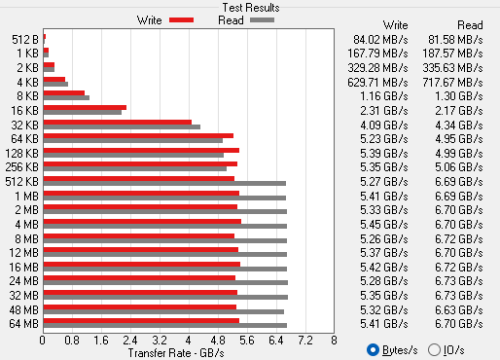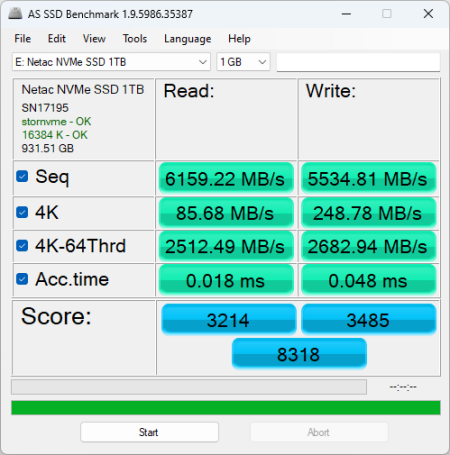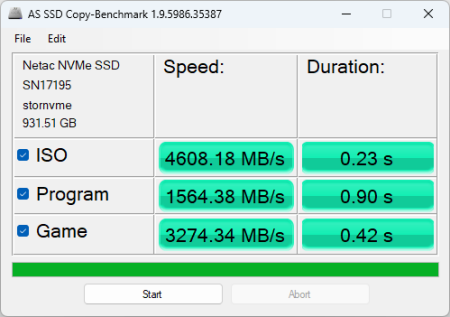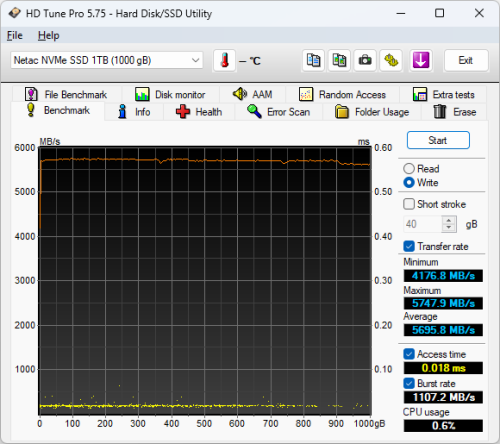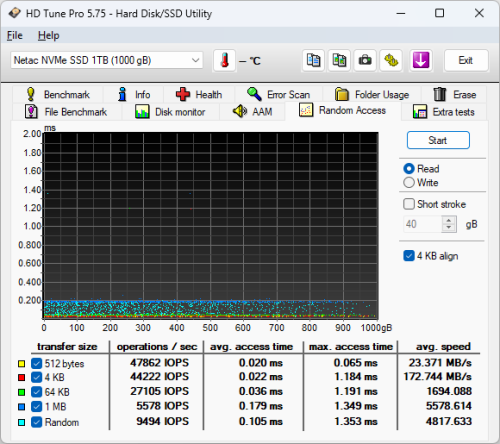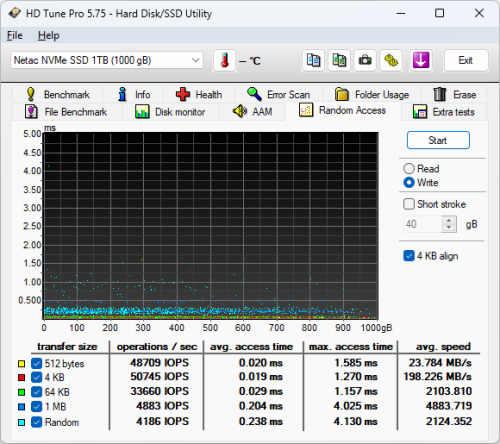

Model: Netac NV7000-Q 1TB PCIe Gen 4x4 Solid State Drive
Manufacturer: Netac
Provided By: Netac
Netac is no stranger to the storage industry. Founded in 1999, this Chinese company made a name for itself early on by inventing the world's first USB flash drive. Since then, Netac has grown to become China's leading storage device manufacturer with a brand channel that covers more than 50 countries. Using market demand as the guide, the company provides a variety of easy-to-use, reliable and fashionable products including solid state drives, memory modules, USB flash drives, memory cards, and storage peripherals.
One of the latest additions to Netac's line of solid state drives is the NV7000-Q. Designed for enthusiasts and gamers, this compact, M.2 form factor drive is powered by Maxio Technology's DRAM-less MAP1602 controller and is available with up to 4TB of YMTC's 232-layer 3D QLC NAND flash. The NV7000-Q also utilizes SLC caching and HMB (Host Memory Buffer) technology and is equipped with an ultra-fast PCIe Gen 4x4 NVMe 1.4 interface to deliver up to 7,100 MB/s read and 6,200 MB/s write speeds.
The NV7000-Q is available in 1TB, 2TB and 4TB capacities. For this review, Netac sent us the 1TB version of the drive which is capable of delivering up to 7,100 MB/s sequential read and 6,200 MB/s sequential write speeds.
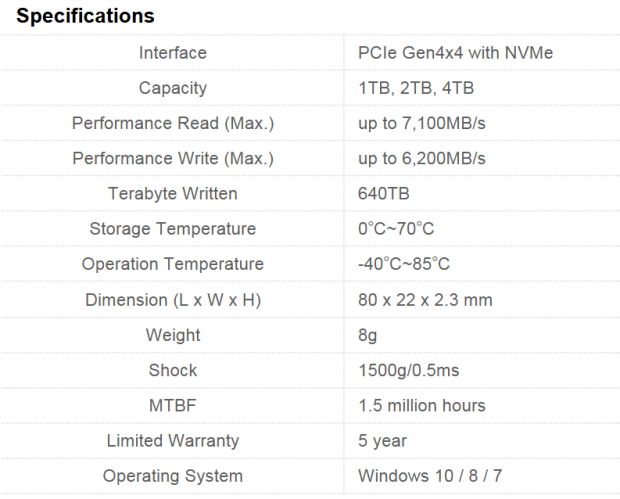
Needless to say, this is only a taste of what the NV7000-Q has to offer. To give you an idea of what to expect, we'll take a closer look at Netac's new PCIe 4.0 SSD and then see how well it performs. Does the NV7000-Q have what it takes? Can it deliver the value and performance that Netac is known for? Keep reading as we find out.

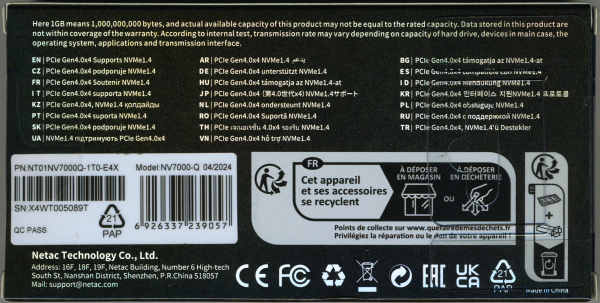
The NV7000-Q comes packaged in an attractive, shiny, black box. Along with a picture of the drive, the packaging advertises a number of its key features including its 1TB capacity and PCIe Gen 4x4 NVMe interface. Inside, you'll find the SSD as well as a small installation guide and a couple of mounting screws.
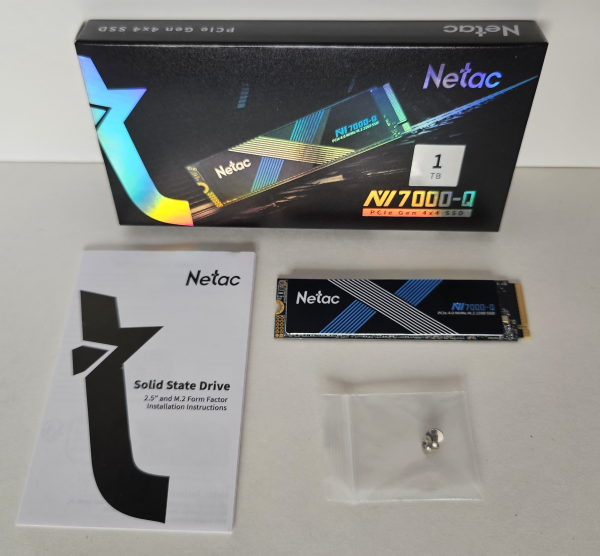
Physical Features:
The NV7000-Q uses the 2280 form factor for M.2 (NGFF) SSDs. It measures 22 x 80 x 2.3 mm and weighs in at 8g. The drive also has an "M key" edge connector which provides PCIe SSDs with up to 4x lanes of bandwidth.

The NV7000-Q is powered by Maxio Technology's MAP1602 controller chip. This DRAM-less, PCIe Gen 4x4 NVMe 2.0 controller is equipped with a quad-core ARM Cortex R5 CPU and has 4 NAND channels with four chip enables (CE) per channel. The MAP1602 also offers support for 3D TLC/QLC NAND flash as well as Maxio's Agile ECC error correction technology.

For the 1TB version of the NV7000-Q, Netac opted to use YMTC's 232-layer 3D QLC NAND flash. If you'd remove the label, you'd see two 512GB NAND flash packages on the top of the PCB. There is also no DRAM cache chip as the NV7000-Q's controller takes full advantage of NVMe's Host Memory Buffer feature by using a small portion of the computer's memory to cache the mapping tables.
The test system used in this review is equipped with an AMD Ryzen 9 7900x CPU, Gigabyte B650E AORUS master motherboard, 32GB (16GB x 2) of Corsair Vengeance 5200MT/s DDR5 memory, Samsung 990 Pro 2TB SSD and a GIGABYTE GeForce GTX 1060 WINDFORCE OC 6G graphics card. For the operating system, I used the latest version of Windows 11.
To test the performance of Netac's NV7000-Q SSD, I ran a series of benchmarks using CrystalDiskMark, ATTO Disk Benchmark, AS SSD, HD Tune Pro, Anvil's Storage Utilities, Iometer and PCMark. For comparison, I've also included test results from the Samsung 990 EVO Plus, Crucial P310 2280, Silicon Power MS70, Crucial P310 2230, Crucial T705, Silicon Power US75, Samsung 990 EVO, Silicon Power PX10, Crucial T500, ADATA SE920, ADATA LEGEND 970, Crucial T700, Solidigm P44 Pro, Samsung 990 PRO, ADATA LEGEND 960, Crucial P3 Plus, SK hynix Platinum P41, Silicon Power XS70, WD_BLACK SN770, ADATA XPG ATOM 50, ADATA XPG GAMMIX S70 Blade, Crucial P5 Plus, Plextor M10PY, ADATA XPG GAMMIX S70, Sabrent Rocket 4 Plus, WD_BLACK SN850, Silicon Power US70, ADATA XPG GAMMIX S50 Lite, Crucial X10 Pro, Crucial X9 Pro, ADATA Elite SE880, Kingston XS2000, ADATA XPG ATOM 30, Samsung 980, Silicon-Power UD70, Crucial P2, SK hynix Gold P31 and Crucial P5.
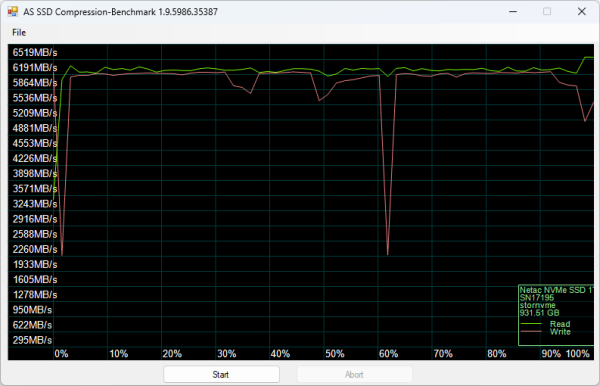
As I mentioned earlier, the NV7000-Q uses Maxio's MAP1602 controller chip. Looking at the screenshot above, you can see that it performs equally well with both incompressible (0%) and compressible (100%) data.
CrystalDiskMark 8.0.5:
First, I ran a few quick tests using CrystalDiskMark. This benchmark measures the performance of a storage device by testing its sequential and random read and write speeds. For this test, we're using the peak and real world profiles.
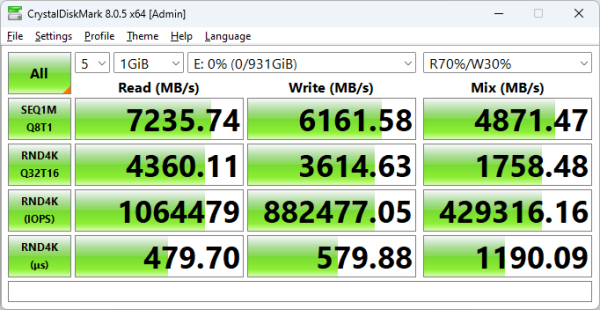
According to Netac, the NV7000-Q is capable of reading at 7,100 MB/s and writing at 6,200 MB/s. While the drive had no problems reaching its rated read speed, it came up a bit short in CrystalDiskMark's sequential write speed test.

As you'd expect, the NV7000-Q wasn't as fast when tested with the "real world" profile which uses a single thread and a much lower queue depth. Nevertheless, it was still able to read at 5,307 MB/s and write at more than 5,800 MB/s.
ATTO Disk Benchmark 4.01:
I also used ATTO Disk Benchmark to test the NV7000-Q's sequential read and write speeds. The tests are run using blocks ranging in size from 512B to 64 MB and the total length set to 256MB.
When tested with ATTO, the NV7000-Q's read speeds topped out at about 6.73 GB/s and its write speeds at 5.45 GB/s.
AS SSD:
AS SSD is a benchmark designed specifically for solid state drives. The application contains five synthetic tests used to determine the sequential and random read and write performance of a drive.
AS SSD also includes a copy benchmark. This test copies an ISO (two large files), program (many small files) and game (small and large files), returning the speed and duration of each.
HD Tune Pro 5.75:
Next, I ran a series of tests using HD Tune Pro. This hard disk utility measures a drive's performance by testing its sequential read and write speeds as well as its access time, burst rate and CPU usage. For this review, I'm also going to use it to benchmark the NV7000-Q's random read and write speeds, random access times and the number of operations per second.
The US75 performed relatively well when benchmarked with HD Tune. The drive had average read and write speeds of 5896.6 MB/s and 5695.8 MB/s, respectively.
When reading 4KB blocks, the NV7000-Q reached 44,222 IOPS and had an average speed of 172.744 MB/s. The drive was even faster when writing, reaching 50,745 IOPS with an average speed of 198.226 MB/s.
Anvil's Storage Utilities:
Anvil's Storage Utilities is another benchmark designed with SSDs in mind. The standard storage benchmark measures a drive's performance by testing its transfer speeds, access times and IOPS.

Iometer:
Lastly, I ran a series of tests using Iometer. This tool can be configured to benchmark a number of things. In this case, I used it to measure the NV7000-Q's read and write speeds and the number of operations per second. The tests were run using random bytes and a queue depth of 3.

The NV7000-Q didn't perform as well as it did in our other tests. When tested with Iometer, the drive was able to read at 6181.09 MB/s and write at only 5053.03 MB/s.
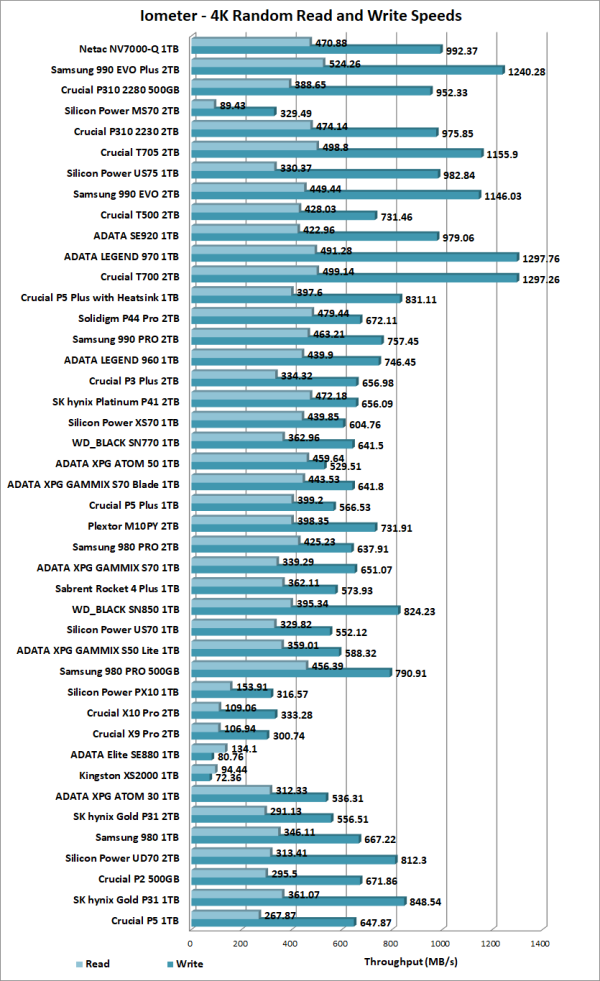
The NV7000-Q performed better when doing random reads and writes. In our tests, the drive was able to read at 470.88 MB/s and write at a blazing 992.37 MB/s.
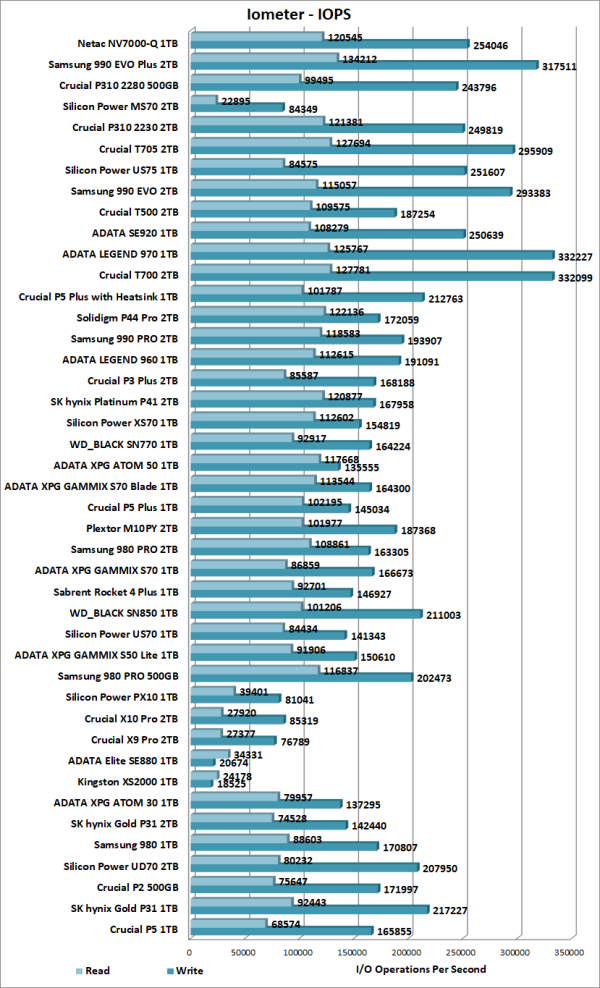
Netac really doesn't say what the NV7000-Q is capable of in regards to IOPS. With two threads and a queue depth of three, the drive reached 120,545 random read IOPS and 254,046 random write IOPS.
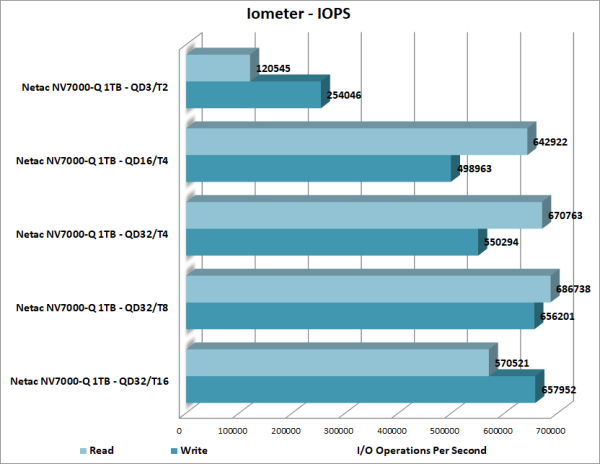
As with most drives, the NV7000-Q performed better with more threads and at higher queue depths. With eight threads and the queue depth set to 32, it reached 686,738 random read IOPS and 656,201 random write IOPS. For whatever reason, the drive's random read performance was actually lower with 16 threads.
PCMark 8 - Storage Test:
PCMark 8 is a complete benchmark for Windows. It includes five benchmark tests, each designed around a specific scenario. The storage benchmark measures drive performance using real-world traces recorded from Adobe Creative Suite, Microsoft Office and a selection of popular games.
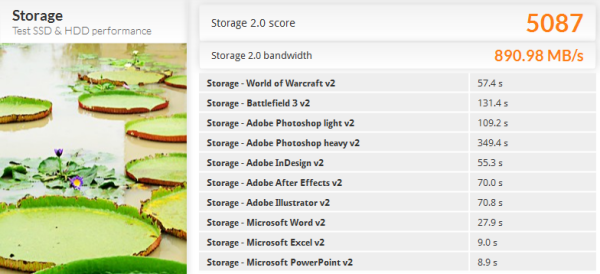
PCMark 8 also includes a consistency test which measures the performance consistency and degradation tendency of a storage system. The test reports the performance level at the start, the degraded steady-state and the recovered state as well as the number of iterations required to reach the degraded state and the recovered state. For this test, we are focusing on the Adobe Photoshop (Heavy) trace and will look at both the bandwidth and latency of the drive

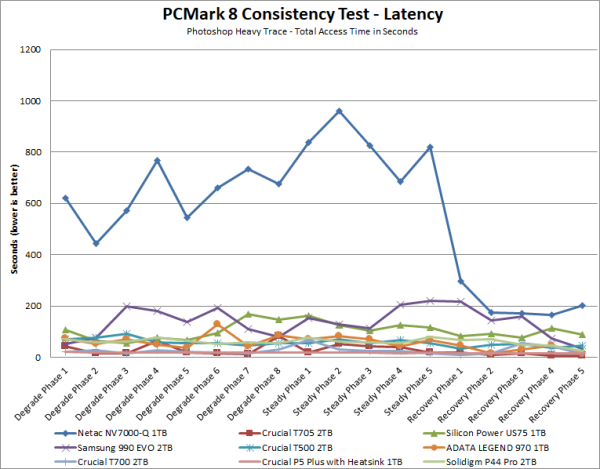
The NV7000-Q didn't do as well as some of the other drives in this test. Its bandwidth dropped below 50 MB/s during the degradation and steady phases, pushing its latency above the 900ms mark. The US75's performance did increase somewhat during the last recovery phase. However, with it topping out at only 210 MB/s, it lagged behind the Samsung 990 EVO and Crucial T500.
PCMark 10 - Full System Drive Benchmark:
PCMark 10's Full System Drive Benchmark uses a wide-ranging set of real-world traces from popular applications and common tasks to fully test the performance of the fastest modern drives. This benchmark produces an overall score as a measure of drive performance. Comparing devices is as simple as comparing scores. The tests also measure and report the bandwidth and average access time performance for the drive.
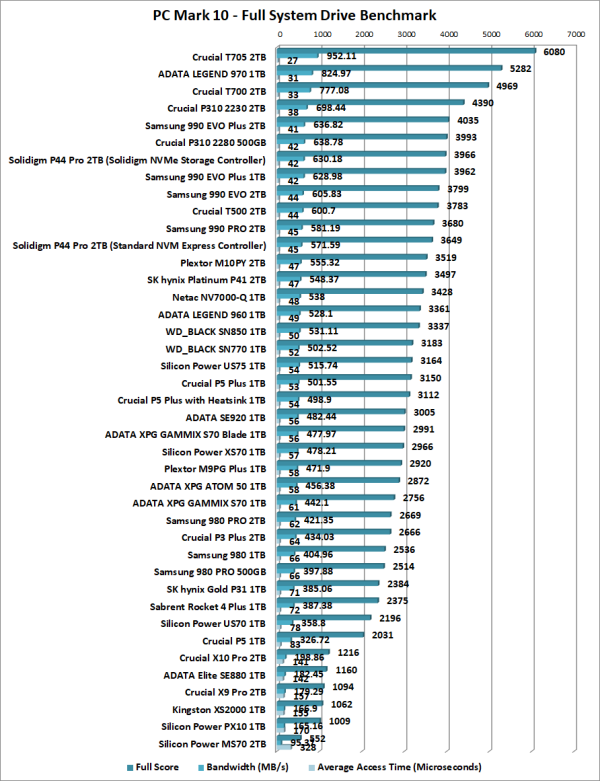
The NV7000-Q performed relatively well for a DRAM-less drive. As you can see, it wasn't nearly as fast as the Crucial T500 or Samsung 990 PRO. However, it scored better than other PCIe 4.0 SSDs like the ADATA LEGEND 960 and Crucial P5 Plus.
Temperature:
While PCIe SSDs like the NV7000-Q offer impressive performance, they also generate a good amount of heat. To prevent themselves from overheating, most SSDs have implemented a mechanism called thermal throttling which automatically reduces a drive's performance when it reaches a certain temperature.
If you're someone looking to get the most out of your SSD, this is something that you don't want to happen. To prevent this drop in performance, the NV7000-Q has an ultra-thin heatspreader built into the label on the top of the drive that helps dissipate heat faster.

The NV7000-Q stayed relatively cool throughout our tests. At idle, temperatures hovered around 34 ºC. When pushed hard, the drive's temperature peaked at 54 ºC when both reading and writing. These temperatures had no impact on the NV7000-Q's performance. No matter how hard I pushed it, the drive did not throttle its read or write speeds in any noticeable way.
Final Thoughts:
The Netac NV7000-Q is a great choice for the gamer or content-creator looking for a fast, yet affordable, PCIe Gen 4 SSD for their computer or PlayStation 5 gaming console. This compact, M.2 form factor drive is powered by Maxio Technology's DRAM-less MAP1602 controller and is available with up to 4TB of YMTC's 232-layer 3D TLC NAND flash. Combine this with NVMe's Host Memory Buffer (HMB) technology and a PCIe Gen 4x4 interface and you have a drive capable of transferring data at nearly twice the speed of most Gen3 SSDs. In our sequential read and write tests, the 1TB version of the NV7000-Q was able to read at speeds as high as 7,235 MB/s and write at speeds in excess of 6,161 MB/s. The drive also did very well in our random write tests, producing more than 254,000 IOPS at low queue depths.
The only real complaint I have about the NV7000-Q is the lack of availability here in the US. The 1TB version of the drive has been available in other countries for a number of months now and major retailers like Amazon or Newegg do not stock it, even though they carry other Netac products. Hopefully this changes now that 2TB and 4TB versions of the NV7000-Q have started to ship.
If you live in Canada though, the NV7000-Q can be purchased from Amazon.ca. The drive is available in 1TB and 2TB capacities which are priced at $119 CAD ($85 USD) and $221 CAD ($157 USD), respectively.

Highs:
- Available in 1TB, 2TB and 4TB capacities
- PCIe 4.0 x4 interface with NVMe protocol
- Maxio MAP1602 controller
- YMTC 232-layer 3D QLC NAND flash
- Good sequential and random read and write performance
- Small M.2 2280 form factor
- Stays relatively cool, even under heavy loads
- Host Memory Buffer (HMB)
- Reasonably priced
- 5 year warranty
Lows:
- Does not support hardware based encryption
- Hard to find in some markets
